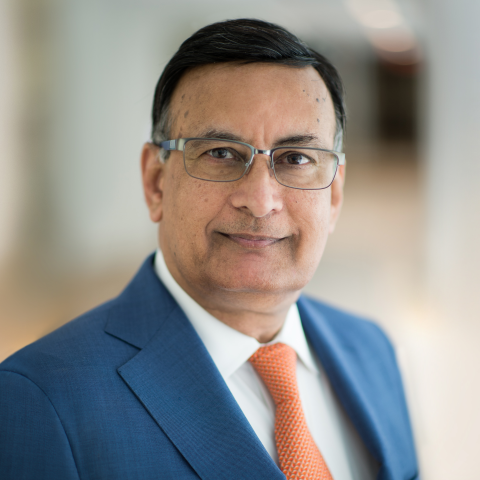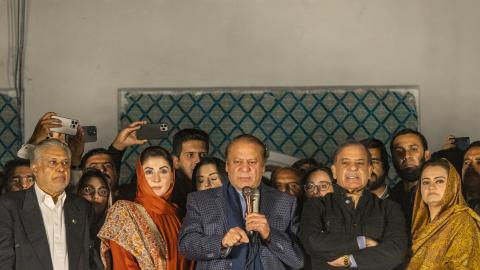In a nutshell
- The new government will have to implement tough reforms while managing political dissatisfaction
- Growth remains sluggish, exacerbated by structural issues and high external debt
- The alliance between ruling elites and the military will likely survive waves of unrest
akistan’s 12th general elections, held on February 8, might not lead to the resolution of the country’s longstanding problems. But the new coalition government, supported by the powerful military-intelligence establishment, could provide a semblance of political stability. With a new International Monetary Fund (IMF) program and strategic investments from China and the Arab Gulf states, Pakistan will likely ride through its immediate economic crisis. Longer term, however, the majority-Muslim country of 240 million – with nuclear weapons and the world’s sixth-largest standing army – will continue to lurch from one crisis to the next.
Political dysfunction
The February 8 elections revealed the dissatisfaction of a young population that lacks economic opportunities and resents both the country’s dynastic political parties and the omnipotent military’s political meddling. Independent candidates affiliated with the Pakistan Tehreek-e-Insaf (PTI) party of the jailed former Prime Minister Imran Khan – barred from running under the party banner – won more directly elected seats in the National Assembly than any of the traditional political parties. But the PTI-affiliated independent candidates failed to secure a majority and could not find coalition partners.
The center-right Pakistan Muslim League (PML), led by three-time prime minister Nawaz Sharif, and the center-left Pakistan People’s Party (PPP), led by former President Asif Ali Zardari and former Foreign Minister Bilawal Bhutto Zardari, secured fewer seats than PTI on election day. Their numbers were bolstered by mandatory quotas; seats reserved for women and religious minorities based on each party’s share of the vote, a privilege not available to independent candidates under Pakistan’s constitution.
Shebaz Sharif, younger brother of Nawaz Sharif, was chosen by the PPP to be prime minister. He had previously held the post between April 2022 and April 2023. In return, the PML has helped the PPP’s Asif Zardari become president, a largely ceremonial position. For all practical purposes, the government is a PML-PPP coalition, though the PPP has chosen not to seek cabinet positions, in an effort to ensure that the PML alone bears responsibility for the difficult economic decisions that lie ahead. The new government will have to expand tax collection and further reduce subsidies on fuel to secure a much-needed IMF bailout.
Pakistan and the disputed Kashmir region
The conflicting territorial claims in Kashmir significantly strain Pakistan’s security as it perpetuates regional tensions with India and fuels militant activities within its borders. The decade-long dispute not only diverts resources from internal development but also exacerbates the threat posed by extremist groups using the conflict as a rallying cause. © GIS
Former cricketer and populist politician Imran Khan, who rose to power with the military’s support five years ago, has rejected the election results, calling them rigged. Initially, the military had propped up Mr. Khan to marginalize traditional politicians who questioned the army’s overarching role in policymaking. But after his removal from office through a parliamentary vote of no confidence, Mr. Khan aggressively confronted the armed forces. He accused them of collaborating with politicians from parties that have traditionally held power, alleging that these dealings were conducted at the urging of the United States.
Mr. Khan’s conspiracy theories have polarized Pakistan, encouraging supporters to attack the military in ways that mainstream politicians avoided. But the unreasonableness of Mr. Khan and his supporters, including their violent assaults on military establishments, have only helped bring the old ruling parties and the military leadership closer together. In the aftermath of the elections, Mr. Khan’s supporters generated much political noise but fell short of creating massive disruption or fomenting a revolution. Although their allegations of interference with the election process are not completely unfounded, it is unlikely that the protesters will be able to overpower the combined might of Pakistan’s entrenched political elite as well as the military and the judiciary.
Military influence
The coalition government will need more than usual levels of support from the military and its intelligence arm to keep Mr. Khan’s supporters at bay and tackle economic challenges. Politics in Pakistan tends to be deeply personal and factional. Leading politicians often ignore parliament and show little regard for press freedom. That is unlikely to change over the next few years. But the new government will need, more than ever, a vision to attract the investment that Pakistan so badly needs.
Most Pakistanis, including the army’s current chief, publicly declare that the military should stay out of politics, but in reality, the army remains the most powerful institution in the country. Historically, the generals have never trusted the country’s politicians and have their own views on how the country should be run.
Mr. Khan’s assault has eroded respect and support for the military in segments of the population that were previously pro-military and hostile to politicians. But now the embattled armed forces have an interest in working with the politicians they previously disparaged, if only to retain their institution’s pre-eminence.
In addition to having the final say on foreign policy and national security, the military also has an interest in reviving Pakistan’s stagnant economy. The army’s constant interference has contributed to long-term structural problems within the economy. This time, the threat from Mr. Khan and his supporters might prevent the past pattern of military leaders toppling leaders they once supported. If such an attempt is made, the new Sharif government might prove to be resilient enough to withstand it.
Structural economic challenges
Pakistan’s gross domestic product (GDP) grew by a meager 0.29 percent in the fiscal year ending June 2023, below the target of 5 percent set the year before. With a GDP of $345 billion, Pakistan’s current external debt stands at $123 billion and the country needs to repay $78 billion before 2026. Pakistan has battled budget and trade deficits for years. Its exports and tax revenues have failed to increase sufficiently, and its foreign currency reserves have never risen beyond the value of a few months’ imports.
The country’s economic crisis is cumulative. It has one of the lowest tax-to-GDP ratios in the world, and remains a cotton and textile economy that has not expanded its industrial output or exports. Pakistan has borrowed from the IMF 23 times since 1958, including 14 times since 1988 and six times since 2000. The funds have mostly been used to cover past debts and refinance current spending, rather than for investments.
Successive Pakistani governments based their budgets on massive international military and non-military assistance from Western countries, primarily the U.S. The strategic considerations that made that largesse possible are now vanishing, making structural reform all the more important.
In the short term, Pakistan needs to reduce the budget deficit and improve export performance, if only to fulfill promises to the IMF. The government would have to reduce expenditures and undertake tax reforms to enhance its revenues. The Sharif government has also promised to privatize state owned enterprises that consistently lose money. A hybrid civil-military Special Investment Facilitation Council has already been created to offer various state-owned enterprises and projects to foreign investors, especially the sovereign wealth funds of Arab Gulf states.
Security crises
Jihadist terrorist groups, often encouraged or tolerated as part of sub-conventional warfare against India, have become a serious security threat to Pakistan itself. Since 2000, 16,636 terrorist attacks resulting in 67,732 deaths have been reported in Pakistan, making it one of the world’s biggest victims of terrorism. In 2023 alone, 1,080 people died as a result of terrorist attacks.
Currently, the Pakistani Taliban group Tehrik-i-Taliban Pakistan (TTP) poses the most serious threat to Pakistan’s security. Although the Afghan Taliban enjoyed active Pakistani support during their fight against the U.S.-backed government, their return to power in Afghanistan has worsened Pakistan’s security crisis. The regime in Kabul continues to maintain its longstanding ties with al-Qaeda and to offer protection to the TTP. Islamic State is also active in the Afghanistan-Pakistan region.
Pakistan’s new government has promised to implement a counter-terrorism plan that targets all violent extremist groups, without distinction. Such promises have been made several times by various Pakistani governments but have never been fully implemented.
This time, it seems that the civil-military impetus to focus on economic progress might encourage decisive action against jihadist terrorism. If such plans materialize, Pakistan could engage in talks with India aimed at opening trade between the two countries – something Pakistan sorely needs in these times of economic adversity.
Scenarios
Pakistan’s deep social, political and economic divisions are unlikely to end anytime soon. Widespread dissatisfaction with the economy and the absence of opportunities for Pakistan’s young and growing population have given rise to populist politics. Populism hinders political reconciliation at home and obstructs the adoption of a rational foreign policy based on Pakistan’s economic interests.
Most likely: A weak civilian government works closely with the military
In the short term, the most likely scenario is that the country will have a relatively weak civilian government cooperating closely with the military, while Imran Khan will remain in prison and his party out of power. There will be considerable political noise, given Mr. Khan’s support especially among Pakistanis abroad, but the government will survive. Politicians in power will look for the military’s support to ensure that tough economic decisions can be made. Assuming the economy stabilizes somewhat, the armed forces will be in a better position to quell any potential street protests and deal with the opposition from Mr. Khan’s supporters.
The priority of the government will be to secure another IMF loan for Pakistan, followed by privatization of state-owned enterprises. The IMF has already approved the release of the last $1.1 billion tranche of the previous bailout package, which has had a positive effect on the stock market. A new $8 billion package is now under negotiation.
Pakistan expects its Gulf state allies to buy some of the state-owned enterprises to help reduce budget deficits and bolster the government’s coffers. An improvement in key economic indicators will be crucial to continued political stability.
Less likely: Khan supporters create widespread unrest
The less likely scenario is that Mr. Khan and his supporters are able to instigate widespread political violence while the economic situation worsens and the next transfer of IMF funds is delayed. The government might have to increase fuel and electricity prices to satisfy IMF conditionalities, giving the opposition an issue with which to incite public resentment. In this case, violence might lead to clamor for the military to take over and restore order. This could result in another round of military intervention or another round of elections, and would not necessarily lead to a victory for the opposition.
Least likely: A revolution led by Mr. Khan or a military coup
The military currently prefers ruling with the help of a civilian facade and will rule directly only in very rare instances. And Mr. Khan’s supporters, though boisterous on social media, are unlikely to be able to mobilize nationwide protests on a sustained basis, making a popular revolution unlikely.



















